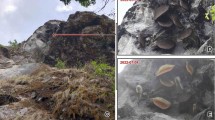Summary
The following study should clear up the structures of the H-shaped profile found in the hairs of some shrews and show if it has a taxonomic signification. Therefore we studied the concerned hair structures by scanning electron microscopy in 8 genera.
The special hair-shape, which is confined to the terminal segment of guard hairs, is found in the species of the following genera:Sorex, Neomys, Blarina andCryptotis, all members of the subfamily Soricinae. All the examined members of the subfamily Crocidurinae, i.e.Crocidura, Praesorex, Suncus andSylvisorex show a simple hair shape.
The H-shaped hair characterizes the Soricinae as a monophyletic unity. Yet, the morphological criteria of hair complete the osteological criteria of Repenning (1967) an plead for the validitiy of the often refuted subfamilies.
Zusammenfassung
Die vorliegende Untersuchung befaßt sich mit besonderen Haarfeinstrukturen der Soricidae, wobei geklärt werden soll, ob dem H-förmigen Haarquerschnitt-Profil eine taxonomische Bedeutung zukommt. Wir überprüften deshalb die betreffenden Haarstrukturen mit Hilfe des REM in 8 Gattungen.
Das besondere Haarprofil, das auf das Terminalsegment der Grannenhaare beschränkt ist, findet sich bei folgenden Gattungen:Sorex, Neomys, Blarina undCryptotis, alles Vertreter der Subfamilie Soricinae. Sämtliche untersuchten Vertreter der Subfamilie Crocidurinae, d.h.Crocidura, Praesorex, Suncus undSylvisorex weisen ein einfaches Haarprofil auf.
Das H-Profil wird als Synapomorphie der Soricinae angesehen und charakterisiert diese als monophyletische Gruppe. Die haarmorphologischen Kriterien ergänzen somit die osteologischen Kriterien von Repenning (1967) und sprechen für die Beibehaltung der von vielen Autoren abgelehnten Subfamilien.
Similar content being viewed by others
Literatur
Appelt, H.: Fellstrukturuntersuchungen an Wasserspitzmäusen. Abh. u. Ber. Naturkundl. Mus. „Mauritianum“ Altenburg8, 81–87 (1973)
Borowski, S.: Saisonale Veränderung der Behaarung der Soricidae. Ann. Univ. M. Curie-Sklodowska, Sect. C,7, 2, 65–117 (1952)
Day, M.G.: Identification of hair and feather remains in the gut and feaces of stoats and weasels. J. Zool. Lond.148, 201–217 (1966)
Dryden, G.L.: Reproduction inSuncus murinus. J. Reprod. Fert. suppl.6, 377–396 (1969)
Dziurdzik, B.: Key to the identification of hairs of mammals from Poland. Acta Zool. Cracoviensia18, 73–92 (1973)
Heather, D.M., Hampton, J.C., Rosario, B.: A simple method for removing the resin from epoxy-embedded tissue. J. Biophysical Biochem. Cytol.9, 909–910 (1961)
Heim de Balsac, H.: L'unité spécifique entreCrocidura giffardi de Winton etC. goliath Th. se trouve démontrée grace aux plus récentes captures effectuées au Cameroun. Bonn. Zool. Beitr.21, 83–88 (1970)
Heim de Balsac, H., Lamotte, M.: Evolution et Phylogénie des Soricidés africains. Mammalia20, 140–167 (1956);21, 15–49 (1957)
Mathiak, H.A.: A key to hairs of the mammls of southern Michigan. J. Wildl. Mgmt.2, 251–268 (1938)
Repenning, C.A.: Subfamilies and genera of the Soricidae. Geolog. Sur. Prof. Pap.565, 1–74 (1967)
Spurr, A.R.: A low-viscosity epoxy resin embedding medium for electron microscopy. J. Ultrastruct. Res.26, 31–43 (1969)
Toldt, K.: Aufbau und natürliche Färbung des Haarkleides der Wildsäugetiere. Deutsche Gesellschaft für Kleintier- und Pelztierzucht, Leipzig (1935)
Vogel, P.: Beitrag zur Fortpflanzungsbiologie der GattungenSorex, Neomys undCrocidura (Soricidae). Verhandl. Naturf. Ges. Basel82, 165–192 (1972a)
Vogel, P.: Vergleichende Untersuchung zum Ontogenesemodus einheimischer Soriciden (Crocidura russula, Sorex araneus undNeomys fodiens). Rev. suisse Zool.79, 1201–1332 (1972b)
Vogel, P.: Energy consumption of european and african shrews. Acta Theriol.21 195–206 (1976)
Walker, E.P.: Mammals of the world, pp. 1500. Baltimore-London: Hopkins 1975
Williams, C.S.: Aids to the identification of mole and shrew hairs with general comments on hair structure and hair determination. J. Wildl. Mgmt.2, 239–250 (1938)
Author information
Authors and Affiliations
Additional information
Mit Unterstützung des Schweizerischen Nationalfonds zur Förderung der wissenschaftlichen Forschung (Nr. 3.515.71, 3.821.72, 3.413-0.74)
Unser Dank gilt Herrn Prof. N. Schönenberger, Herrn Prof.R. Krstic und Frau C. Regamey, die uns bei der histologischen Präparation behilflich waren, insbesondere auch Herrn Dr. T. Jalanti, der uns in die REM-Technik einführte. Kostbares Material wurde uns von Frau A. Geraets (Bonn), Herrn Prof. U. Rahm (Basel) und Herrn Dr. V. Aellen (Genf) zur Verfügung gestellt; auch ihnen sei hierfür herzlich gedankt.
Rights and permissions
About this article
Cite this article
Vogel, P., Köpchen, B. Besondere Haarstrukturen der Soricidae (Mammalia, Insectivora) und ihre taxonomische Deutung. Zoomorphologie 89, 47–56 (1978). https://doi.org/10.1007/BF00993781
Received:
Issue Date:
DOI: https://doi.org/10.1007/BF00993781




